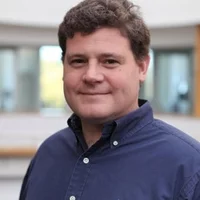Biography
Martin Huppert is a laser engineer in the Gun Laser Group (Laboratory of Nonlinear Optics) at the Paul Scherrer Institut. He studied interdisciplinary sciences at ETH Zurich and completed with a master thesis carried out at MIT-Harvard Center for Ultracold Atoms. There he gained first hands-on experience with ultrafast lasers by building a stabilization system for an octave spanning optical frequency comb. Afterwards, he joined the Laboratory of Physical Chemistry at ETH Zurich to obtain his doctoral degree. Martin Huppert worked on two separate topics, first on high-resolution frequency domain spectroscopy on isolated single molecules at cryogenic temperature. Later, he moved on to ultrafast spectroscopy on the attosecond time scale. In 2016 he received his doctoral degree (Dr. sc. ETH Zurich) under the supervision of Prof. Hans Jakob Wörner with the title: "Actively-Stabilized Attosecond Beamline and Its Application to Attosecond Dynamics in Atoms, Molecules, and Liquids".
Since 2017 Dr. Martin Huppert is part of the Laboratory of Nonlinear Optics at Paul Scherrer Institute.
Institutional Responsibilities
Martin Huppert currently supports the operation and the development of the photocathode and seeding lasers for SwissFEL. This especially includes maintenance and further development of the laser systems, which are leading towards an even more reliable and higher performance operation of SwissFEL.
Scientific Research
Martin Huppert's research interests range from applied laser engineering over short optical pulse generation and detection towards atomic and molecular physics. At the moment, he is mainly involved in technology development at the interface between optical lasers and electron accelerators. This also includes the current development in SwissFEL to produce coherent, attosecond FEL radiation in the soft X-ray spectral range at the Athos FEL line.
Selected Publications
For an extensive overview we kindly refer you to our publication repository DORA.
The SwissFEL soft X-ray free-electron laser beamline, Abela R, Alarcon A, Alex J, et al., Athos. J Synchrotron Radiat. 2019;26(Pt 4):1073‐1084 (2019). doi:10.1107/S1600577519003928
The SwissFEL soft X-ray free-electron laser (FEL) beamline Athos will be ready for user operation in 2021. Its design includes a novel layout of alternating magnetic chicanes and short undulator segments. Together with the APPLE X architecture of undulators, the Athos branch can be operated in different modes producing FEL beams with unique characteristics ranging from attosecond pulse length to high-power modes.
The following publications were published with affiliation to ETH Zurich:
Time-resolved x-ray absorption spectroscopy with a water window high-harmonic source, Y. Pertot, C. Schmidt, M. Matthews, A. Chauvet, M. Huppert, V. Svoboda, A. von Conta, A. Tehlar, D. Baykusheva, J.-P. Wolf, H. J. Wörner. Science, 355, 6322 (2017), pp. 264–267.
doi: 10.1126/science.aah6114.
Time-resolved x-ray absorption spectroscopy (TR-XAS) has so far practically been limited to large-scale facilities, to subpicosecond temporal resolution, and to the condensed phase. We report the realization of TR-XAS with a temporal resolution in the low femtosecond range by developing a tabletop high-harmonic source reaching up to 350 electron volts, thus partially covering the spectral region of 280 to 530 electron volts, where water is transmissive. We used this source to follow previously unexamined light-induced chemical reactions in the lowest electronic states of isolated CF4+ and SF6+ molecules in the gas phase. By probing element-specific core-to-valence transitions at the carbon K-edge or the sulfur L-edges, we characterized their reaction paths and observed the effect of symmetry breaking through the splitting of absorption bands and Rydberg-valence mixing induced by the geometry changes.
Streaking of 43-attosecond soft-X-ray pulses generated by a passively CEP-stable mid-infrared drive, T. Gaumnitz, A. Jain, Y. Pertot, M. Huppert, I. Jordan, F. Ardana-Lamas, H. J. Wörner. Optics Express, 25, 22 (2017), p. 27506.
doi: 10.1364/OE.25.027506.
Attosecond metrology has so far largely remained limited to titanium:sapphire lasers combined with an active stabilization of the carrier-envelope phase (CEP). These sources limit the achievable photon energy to ∼100 eV which is too low to access X-ray absorption edges of most second- and third-row elements which are central to chemistry, biology and material science. Therefore, intense efforts are underway to extend attosecond metrology to the soft-X-ray (SXR) domain using mid-infrared (mid-IR) drivers. Here, we introduce and experimentally demonstrate a method that solves the long-standing problem of the complete temporal characterization of ultra-broadband (≫10 eV) attosecond pulses. We generalize the recently proposed Volkov-transform generalized projection algorithm (VTGPA) to the case of multiple overlapping photoelectron spectra and demonstrate its application to isolated attosecond pulses. This new approach overcomes all key limitations of previous attosecond-pulse reconstruction methods, in particular the central-momentum approximation (CMA), and it incorporates the physical, complex-valued and energy-dependent photoionization matrix elements. These properties make our approach general and particularly suitable for attosecond supercontinua of arbitrary bandwidth. We apply this method to attosecond SXR pulses generated from a two-cycle mid-IR driver, covering a bandwidth of ∼100 eV and reaching photon energies up to 180 eV. We extract an SXR pulse duration of (43±1) as from our streaking measurements, defining a new world record. Our results prove that the popular and broadly available scheme of post-compressing the output of white-light-seeded optical parametric amplifiers is adequate to produce high-contrast isolated attosecond pulses covering the L-edges of silicon, phosphorous and sulfur. Our new reconstruction method and experimental results open the path to the production and characterization of attosecond pulses lasting less than one atomic unit of time (24 as) and covering X-ray absorption edges of most light elements.
Attosecond Delays in Molecular Photoionization, M. Huppert, I. Jordan, D. Baykusheva, A. von Conta, H. J. Wörner.Physical Review Letters, 117, 9 (2016).
doi: 10.1103/PhysRevLett.117.093001.
We report measurements of energy-dependent photoionization delays between the two outermost valence shells of N2O and H2O. The combination of single-shot signal referencing with the use of different metal foils to filter the attosecond pulse train enables us to extract delays from congested spectra. Remarkably large delays up to 160 as are observed in N2O, whereas the delays in H2O are all smaller than 50 as in the photon-energy range of 20–40 eV. These results are interpreted by developing a theory of molecular photoionization delays. The long delays measured in N2O are shown to reflect the population of molecular shape resonances that trap the photoelectron for a duration of up to ∼110 as. The unstructured continua of H2O result in much smaller delays at the same photon energies. Our experimental and theoretical methods make the study of molecular attosecond photoionization dynamics accessible.
Attosecond beamline with actively stabilized and spatially separated beam paths, M Huppert, I Jordan, H J Wörner. The Review of scientific instruments, 86, 12 (2015), p. 123106.
doi: 10.1063/1.4937623.
We describe a versatile and compact beamline for attosecond spectroscopy. The setup consists of a high-order harmonic source followed by a delay line that spatially separates and then recombines the extreme-ultraviolet (XUV) and residual infrared (IR) pulses. The beamline introduces a controlled and actively stabilized delay between the XUV and IR pulses on the attosecond time scale. A new active-stabilization scheme combining a helium-neon-laser and a white-light interferometer minimizes fluctuations and allows to control delays accurately (26 as rms during 1.5 h) over long time scales. The high-order-harmonic-generation region is imaged via optical systems, independently for XUV and IR, into an interaction volume to perform pump-probe experiments. As a consequence of the spatial separation, the pulses can be independently manipulated in intensity, polarization, and frequency content. The beamline can be combined with a variety of detectors for measuring attosecond dynamics in gases, liquids, and solids.

